Diurnal Variation in Cloud Liquid Water Path Derived from Five Cross-Track Microwave Radiometers Onboard Polar-Orbiting Satellites
Abstract
1. Introduction
2. Materials and Methods
2.1. Some Characteristic Differences between AMSU-A and ATMS
2.2. The ATMS Remapping Algorithm
2.3. Diurnal Variation Calculation
3. Results of ATMS LWP Derived with and without the Remapping
4. Discussions on LWP When Merging S-NPP ATMS with Other Satellite Microwave Sounders
5. Summary and Conclusions
Author Contributions
Funding
Acknowledgments
Conflicts of Interest
References
- Wood, R.; Bretherton, C.S.; Hartmann, D.L. Diurnal cycle of liquid water path over the subtropical and tropical oceans. Geophys. Res. Lett. 2002, 29, 7-1–7-4. [Google Scholar] [CrossRef]
- O’Dell, C.W.; Wentz, F.J.; Bennartz, R. Cloud liquid water path from satellite-based passive microwave observations: A new climatology over the global ocean. J. Clim. 2008, 21, 1721–1739. [Google Scholar] [CrossRef]
- Elsaesser, G.S.; O’Dell, C.W.; Lebsock, M.D.; Bennartz, R.; Greenwald, T.J.; Wentz, F.J. The multisensor advanced climatology of liquid water path (MAC-LWP). J. Clim. 2017, 30, 10193–10210. [Google Scholar] [CrossRef]
- O’Neill, L.W.; Wang, S.; Jiang, Q. Satellite climatology of cloud liquid water path over the Southeast Pacific between 2002 and 2009. Atmos. Chem. Phys. Discuss. 2011, 11, 31159–31206. [Google Scholar]
- Zou, X.; Weng, F.; Zhang, B.; Lin, L.; Qin, Z.; Tallapragada, V. Impact of ATMS radiance data assimilation on hurricane track and intensity forecasts using HWRF. J. Geophys. Res. Atmos. 2013, 118, 11558–11576. [Google Scholar] [CrossRef]
- Zou, X.; Qin, Z.; Weng, F. Impacts from assimilation of one data stream of AMSU-A and MHS radiances on quantitative precipitation forecasts. Q. J. Roy. Meteor. Soc. 2017, 143, 731–743. [Google Scholar] [CrossRef]
- Spencer, R.W.; Christy, J.R.; Grody, N.C. Global atmospheric temperature monitoring with satellite microwave measurements: Method and results 1979–1984. J. Clim. 1990, 3, 1111–1128. [Google Scholar]
- Weng, F.; Zou, X. 30-year atmospheric temperature trend derived by one-dimensional variational data assimilation of MSU/AMSU-A observations. Clim. Dynam. 2014, 43, 1857–1870. [Google Scholar] [CrossRef]
- Zou, X.; Qin, Z.; Weng, F. Improved quantitative precipitation forecasts by MHS radiance data assimilation with a newly added cloud detection algorithm. Mon. Weather Rev. 2013, 141, 3203–3221. [Google Scholar] [CrossRef]
- Qin, Z.; Zou, X. Development and evaluation of a new index for MHS cloud detection over land. J. Meteor. Res. 2016, 30, 12–37. [Google Scholar] [CrossRef]
- NOAA KLM User’s Guide, Section 3.3. National Oceanic Atmospheric Administration: Washington, DC, USA. Available online: https://www1.ncdc.noaa.gov/pub/data/satellite/publications/podguides/N-15%20thru%20N-19/pdf/0.0%20NOAA%20KLM%20Users%20Guide.pdf (accessed on 26 May 2020).
- Weng, F.; Zou, X.; Sun, N.; Blackwell, W.J.; Leslie, V.; Yang, H.; Wang, X.; Lin, L.; Tian, M.; Mo, T. Calibration of Suomi National Polar-Orbiting Partnership (NPP) Advanced Technology Microwave Sounder (ATMS). J. Geophys. Res. Atmos. 2013, 118, 11187–11200. [Google Scholar] [CrossRef]
- Atkinson, N.C. NWP SAF Annex to AAPP scientific documentation: Pre-processing of ATMS and CrIS Version 1.0. 2011, EUMETSAT Satellite Application Facility on Numerical Weather Prediction (NWP SAF). The European Organisation for the Exploitation of Meteorological Satellites (EUMETSAT). Available online: https://www.nwpsaf.eu/site/download/documentation/aapp/NWPSAF-MO-UD-027_ATMS_CrIS.pdf (accessed on 26 May 2020).
- Sorensen, H.; Jones, D.; Heideman, M.; Burrus, C. Real-valued fast Fourier transform algorithms. IEEE Trans. Acoust. Speech Signal. Process. 1987, 35, 849–863. [Google Scholar] [CrossRef]
- Bormann, N.; Bell, W.; Fouilloux, A.; Ioannis, M.; Atkinson, N.; Swadley, S. Initial results from using ATMS data at ECMWF. In Proceedings of the 18th International TOVS Study Conference, Toulouse, France, 21–27 March 2012; Available online: http://cimss.ssec.wisc.edu/itwg/itsc/itsc18/program/files/links/1.17_Bormann_pa.pdf (accessed on 19 June 2020).
- Doherty, A.; Atkinson, N.; Bell, W.; Smith, A. An assessment of data from the advanced technology microwave sounder at the Met Office. Adv. Meteorol. 2015, 2015, 956920. [Google Scholar] [CrossRef]
- Zhu, Y.; Gayno, G.; Purser, R.J.; Su, X.; Yang, X. Expansion of the all-sky radiance assimilation to ATMS at NCEP. Mon. Weather Rev. 2019, 147, 2603–2620. [Google Scholar] [CrossRef]
- Zhou, J.; Hu, Y. Comparison of the Remapping Algorithms for the Advanced Technology Microwave Sounder (ATMS). Remote Sens. 2020, 12, 672. [Google Scholar] [CrossRef]
- Tang, F.; Zou, X. Diurnal variation of liquid water path derived from two polar-orbiting FengYun-3 microwave radiation imagers. Geophys. Res. Lett. 2018, 45, 6281–6288. [Google Scholar] [CrossRef]
- Chen, H.; Zou, X.; Qin, Z. Effects of diurnal adjustment on biases and trends derived from inter-sensor calibrated AMSU-A data. Front. Earth Sci. 2018, 12, 1–16. [Google Scholar] [CrossRef]
- Weng, F.; Zou, X.; Wang, X.; Yang, S.; Goldberg, M.D. Introduction to Suomi NPP ATMS for NWP and tropical cyclone applications. J. Geophy. Res. Atmos. 2012, 117, 1–14. [Google Scholar]
- Xia, X.; Zou, X. Impacts of AMSU-A inter-sensor calibration and diurnal correction on satellite-derived linear and nonlinear decadal climate trends of atmospheric temperature. Clim. Dynam. 2020, 54, 1245–1265. [Google Scholar] [CrossRef]
- Minnis, P.; Harrison, E.F. Diurnal variability of regional cloud and clear-sky radiative parameters derived from GOES data. Part I: Analysis method. J. Appl. Meteor. 1984, 23, 993–1011. [Google Scholar] [CrossRef]
- Garreaud, R.D.; Munoz, R. The diurnal cycle in circulation and cloudiness over the subtropical southeast Pacific: A modeling study. J. Clim. 2004, 17, 1699–1710. [Google Scholar] [CrossRef]
- Painemal, D.; Greenwald, T.; Cadeddu, M.; Minnis, P. First extended validation of satellite microwave liquid water path with ship-based observations of marine low clouds. Geophys. Res. Lett. 2016, 43, 6563–6570. [Google Scholar] [CrossRef]
- Lebsock, M.; Hui, S. Application of active spaceborne remote sensing for understanding biases between passive cloud water path retrievals. J. Geophy. Res. Atmos. 2014, 119, 8962–8979. [Google Scholar] [CrossRef]
- Greenwald, T.J.; Bennartz, R.; Lebsock, M.; Teixeira, J. An uncertainty data set for passive microwave satellite observations of warm cloud liquid water path. J. Geophy. Res. Atmos. 2018, 123, 3668–3687. [Google Scholar] [CrossRef] [PubMed]

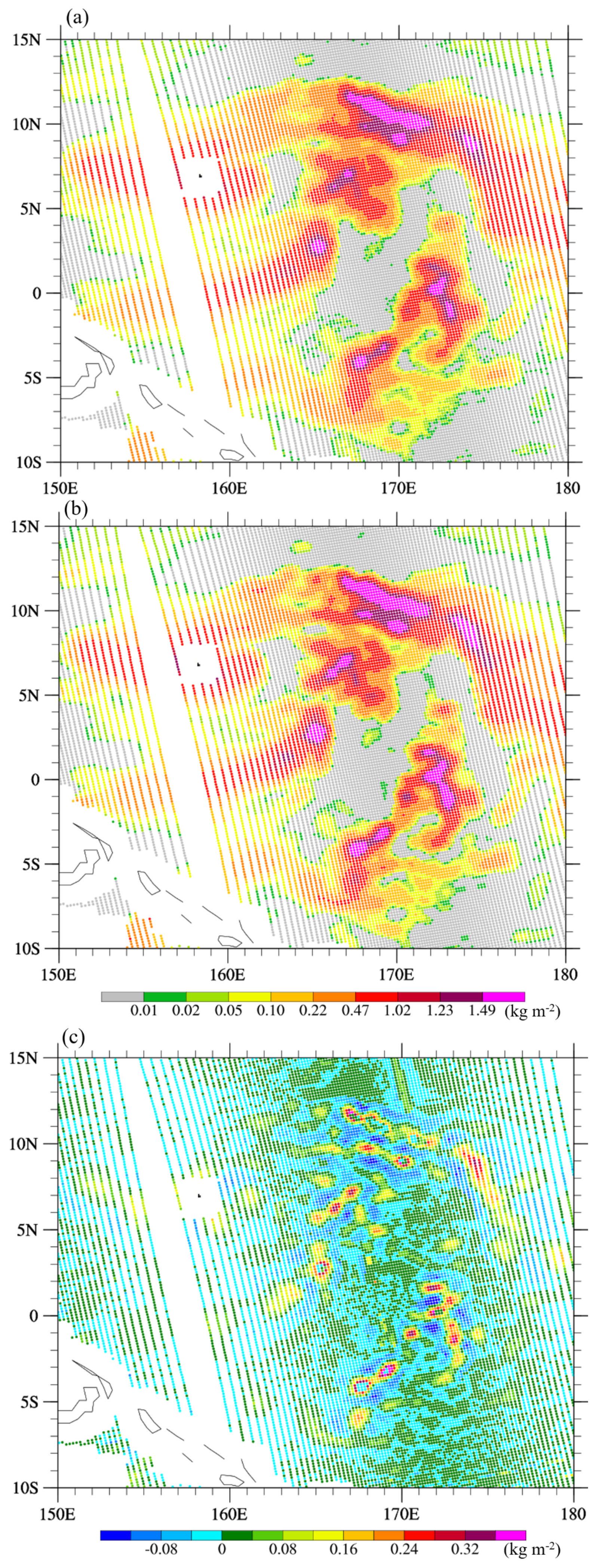
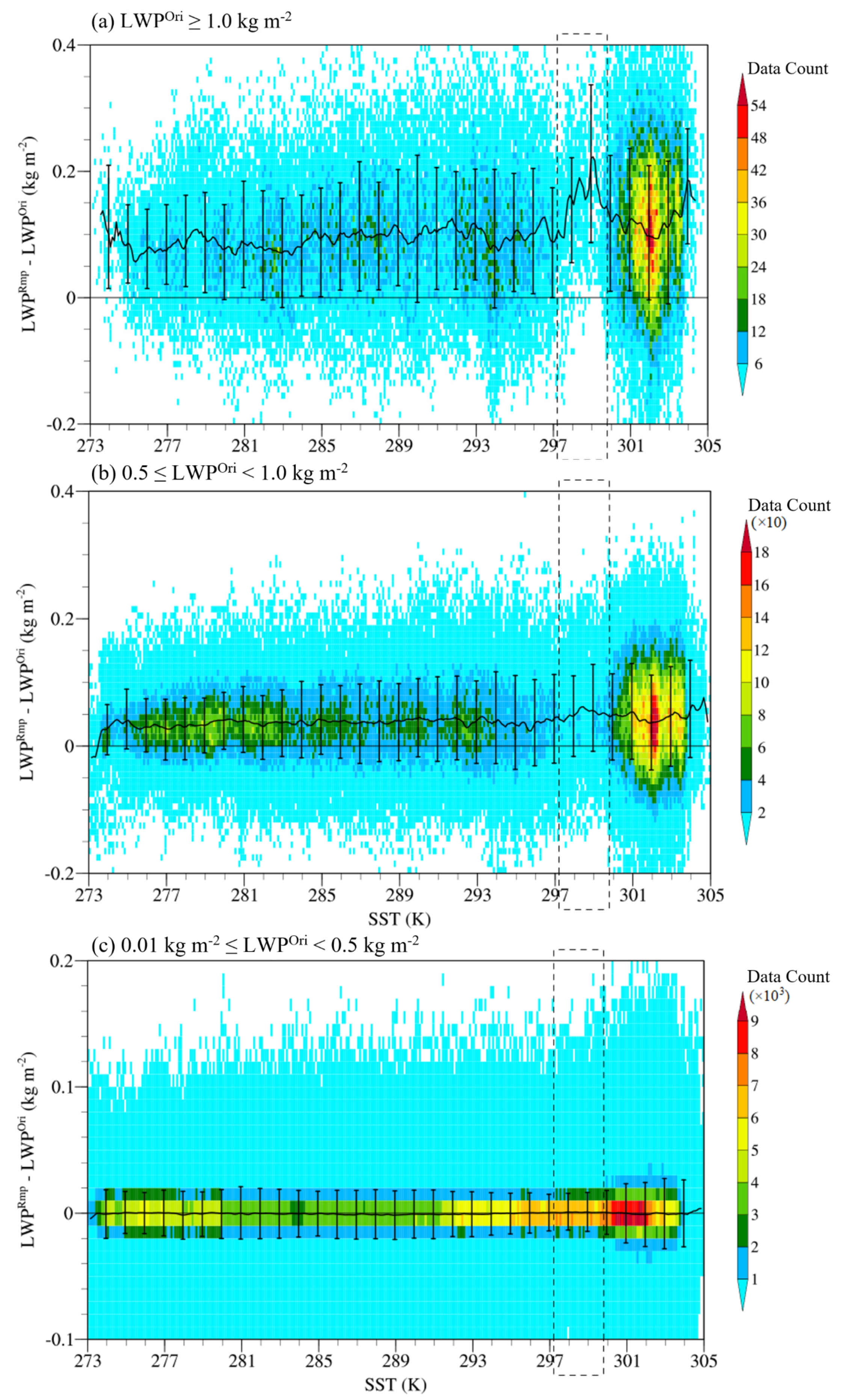
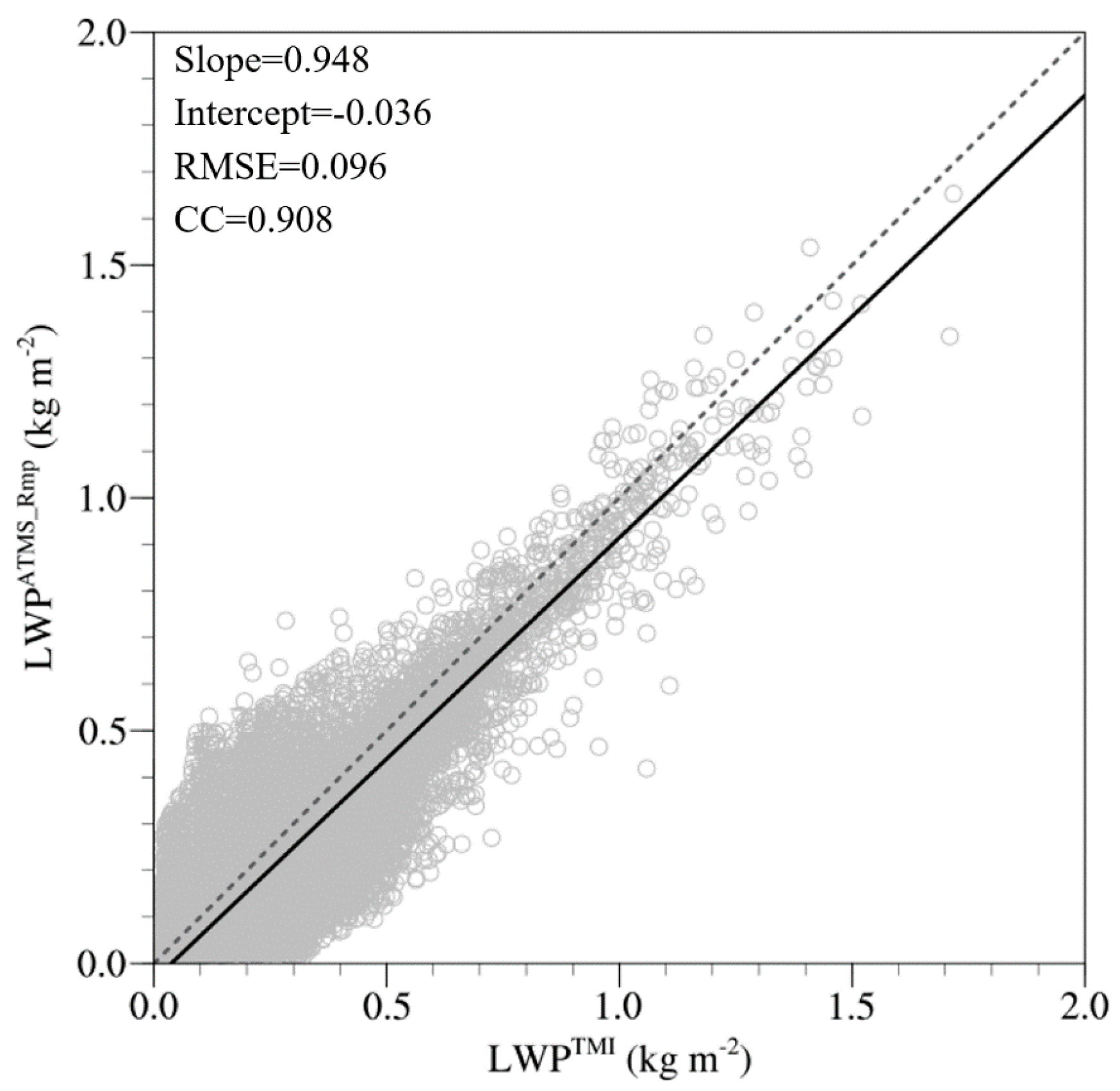

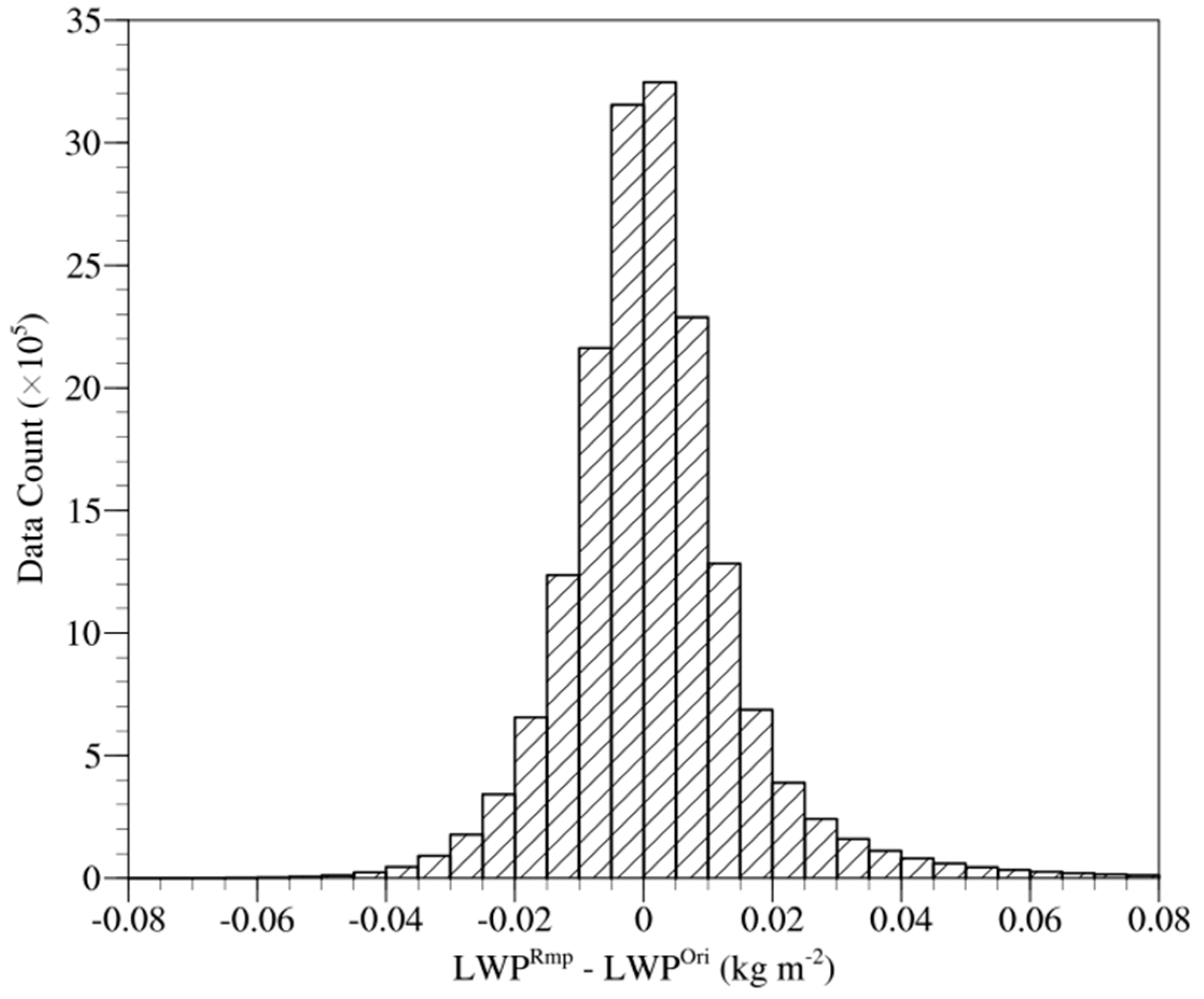
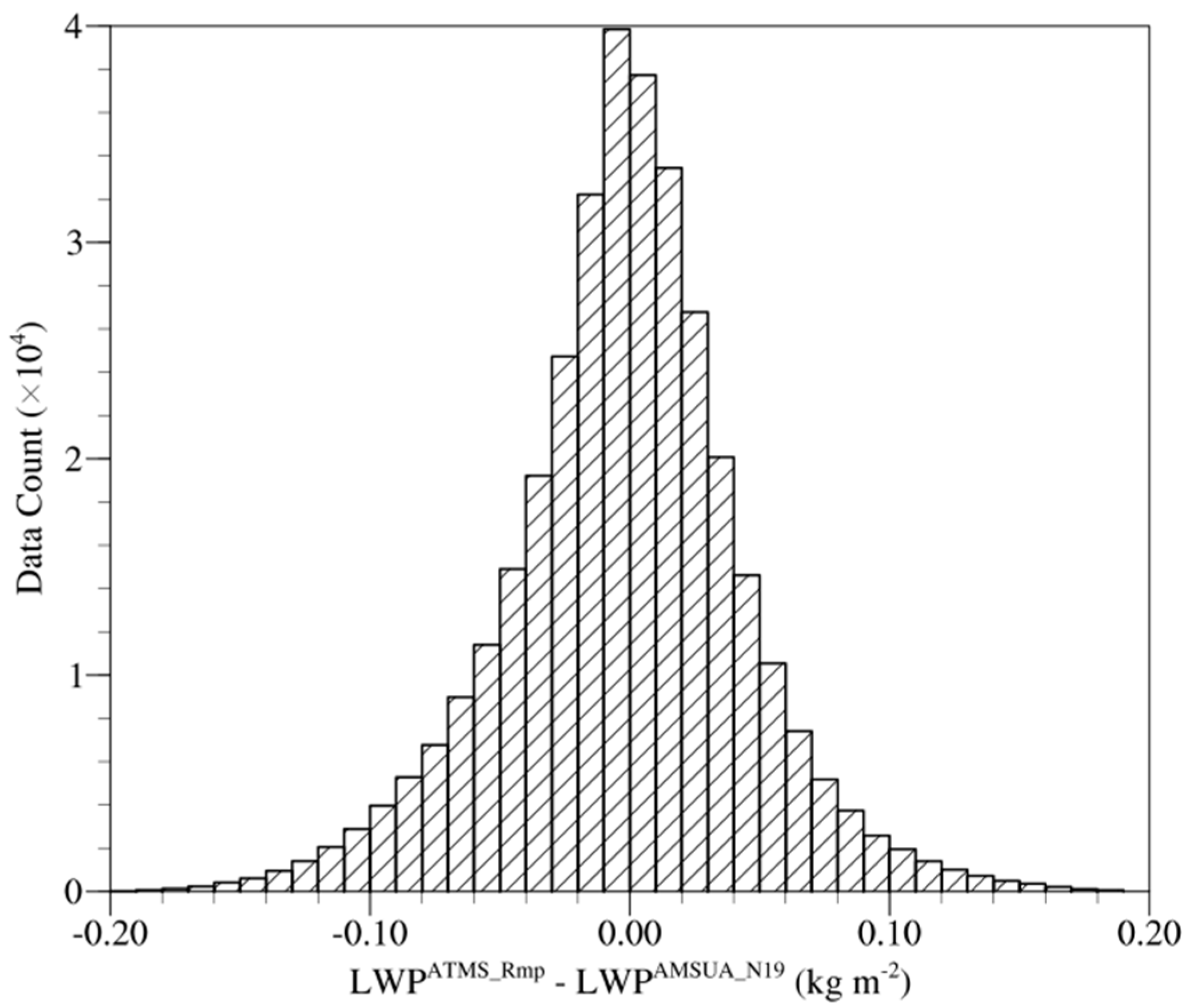



© 2020 by the authors. Licensee MDPI, Basel, Switzerland. This article is an open access article distributed under the terms and conditions of the Creative Commons Attribution (CC BY) license (http://creativecommons.org/licenses/by/4.0/).
Share and Cite
Lin, L.; Zou, X. Diurnal Variation in Cloud Liquid Water Path Derived from Five Cross-Track Microwave Radiometers Onboard Polar-Orbiting Satellites. Remote Sens. 2020, 12, 2177. https://doi.org/10.3390/rs12142177
Lin L, Zou X. Diurnal Variation in Cloud Liquid Water Path Derived from Five Cross-Track Microwave Radiometers Onboard Polar-Orbiting Satellites. Remote Sensing. 2020; 12(14):2177. https://doi.org/10.3390/rs12142177
Chicago/Turabian StyleLin, Lin, and Xiaolei Zou. 2020. "Diurnal Variation in Cloud Liquid Water Path Derived from Five Cross-Track Microwave Radiometers Onboard Polar-Orbiting Satellites" Remote Sensing 12, no. 14: 2177. https://doi.org/10.3390/rs12142177
APA StyleLin, L., & Zou, X. (2020). Diurnal Variation in Cloud Liquid Water Path Derived from Five Cross-Track Microwave Radiometers Onboard Polar-Orbiting Satellites. Remote Sensing, 12(14), 2177. https://doi.org/10.3390/rs12142177






